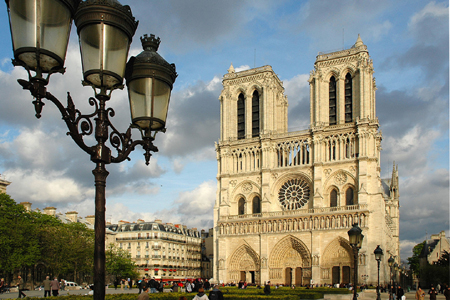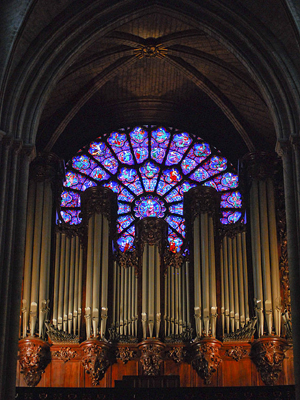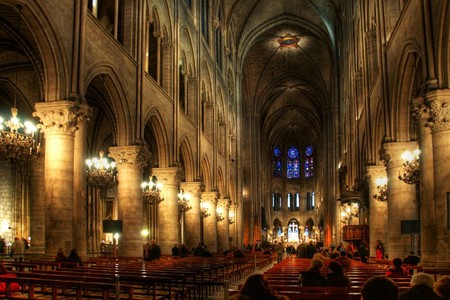| |
 |
 |
 |
| Comment on this report, or find other reports. |
 |
| Our Mystery Worshippers are volunteers who warm church pews for us around the world. If you'd like to become a Mystery Worshipper, start here. |
 |
| Find out how to reproduce this report in your church magazine or website. |
|
|
| 2854: Cathédrale Notre-Dame de Paris, France |
 |

Photo:
© Guido R and used under license
|
 |
Mystery Worshipper: Beggarman.
The church: Cathédrale Notre-Dame de Paris, France.
Denomination: Roman Catholic, Archdiocese of Paris.
The building: One of the best known church buildings in the world, widely considered to be one of the finest examples of Gothic architecture ever built. Begun in 1163 with the cornerstone (as legend has it) laid by Pope Alexander III, and substantially completed by 1345, it pioneered the use of flying buttresses, thus making thinner walls practical. The cathedral was altered, damaged and restored over the years as the history of France unfolded. The building is probably best known for its bells. Leaving aside the literary imaginings of Victor Hugo, it is true that the great Emmanuel bell has sounded at all the major moments in modern French history. Most of the rest of the peal were 19th-century replacements, themselves replaced for the 850th birthday celebrations by a new set, cast from the medieval blueprints but rung via electric motors rather than by hand. The cathedral houses one of the most important collection of relics in the world, including those thought to be the Crown of Thorns, a fragment of the True Cross, and one of the Holy Nails. Notre-Dame is also a concert venue and, of course, a major tourist attraction (13 million visitors a year).
The church: Several major events in the history of England, France and the world have taken place at Notre-Dame. In 1431, Henry VI of England was crowned King of France. In 1537, James V of Scotland was married to Madeleine of France. In 1558, Mary Queen of Scots was married to the Dauphin Francis. In 1804, Pope Pius VII officiated at the coronation of Napoleon I and his wife Joséphine. In 1970 General Charles de Gaulle was buried from here. The list goes on and on. Today, Notre-Dame is still very much a working church. The liturgical schedule, in addition to daily mass, includes vespers every evening and lauds on Sundays. Confessions are heard in French, English, Italian, Spanish, Portuguese, German, Lebanese, Arabic, Chinese, Japanese and other languages. The cathedral also has an important civic role: when I was there, they were hosting the annual Fête du Pain (Festival of Bread), where the public can meet bakers and learn about the art of breadmaking, as well as explore job opportunities in the baking industry. This being France, the Fête du Pain is a major event. The main liturgical happening would be that evening, with the Archbishop of Paris presiding at a mass attended by representatives of the baking industry and broadcast live on French TV.
The neighbourhood: Notre-Dame is in the Île de la Cité, the site of medieval Paris and one of the two remaining natural islands in the River Seine. The original cathedral that Notre-Dame replaced was located here. Although there are some residential quarters, the island is noted primarily for its historical treasures: the Pont Neuf, dating from 1607, is the oldest bridge in Paris; the Conciergerie, once part of the Royal Palace and later a prison housing the likes of Napoleon III, Charlotte Corday and Marie Antoinette, is a popular tourist attraction.
The cast: Presiding and preaching: Père Jacques de Longeaux, chaplain. Choir and altar party were a tiny group (maybe half a dozen).
The date & time: Sixth Sunday of Easter, 10 May 2015, 10.00am.
What was the name of the service?
Messe Grégorienne du Chapitre Cathédral (Gregorian Mass of the Cathedral Chapter).
How full was the building?
The front portion of the nave was packed like sardines; there was more room further back. There was a constant flow of visitors around the sides and at the back.
Did anyone welcome you personally?
Yes. The moment I switched from the general queue to get in, to the queue labelled "Worshippers", it was all warm smiles and friendly Bonjours from the welcomers. Inside, sidesmen and neighbours were extremely solicitous.
Was your pew comfortable?
Yes, the modern seating was extremely comfortable. This was just as well, considering the considerable length of time we were going to be stuck there unable to see or hear anything very much.
How would you describe the pre-service
atmosphere?
Among the worshippers: quiet, expectant, focused.
What were the exact opening words of the
service?
The words of the introit for the day: Vocem iucunditatis annuntiate, et audiatur, alleluia (Speak out with a voice of joy, and let it be heard, alleluia) (Isaiah 48:20).
What books did the congregation use during the
service?
None: we were given three separate sheets specially printed for the occasion, with words (and translations into many languages), music (notated in neumes), and information about the coming week.
What musical instruments were played?
The great organ, but naturally the singing was unaccompanied. Notre-Dame's great organ is by organ builder Aristide Cavaillé-Coll and has been played by such greats as Maurice Duruflé, Louis Vierne and Gervais-François Couperin.

Photo:
© Eric Chan and used under license
Did anything distract you?
At one point I heard what sounded like a gunshot, followed by a scream. "Oh, no, someone's been shot!" I thought. However, everyone around me remained perfectly calm, as if they were used to this sort of thing. Phlegmatic Parisians didn’t react at all, so neither did I: we all trusted the "home team" to offer whatever help was needed, while the best thing we could do was to let them get on with it, while we carried on. Later I learned that the disturbance had been caused by a "regular" with mental health issues and was a frequent occurrence.
Was the worship stiff-upper-lip, happy clappy, or
what?
A wonderful mix of trad and post-Vatican II. Much of the ceremonial around the altar appeared not to have changed since 1163, but the demeanour of the celebrant was totally relaxed – and that sense of enjoying the liturgy (being at home in it) percolated down to the rest of us. We started in Latin, but switched to French for all the spoken lines and those prayers intoned by the celebrant alone. Vestments, white and gold for Easter season, were unimaginative in design. Almost everything and everyone – even the Paschal candle – was solemnly censed – almost, I say, for the congregation were not. But however precisely and correctly everything was done, the fact remained that this mass was being said from the nave altar, facing the people. One rather strange touch: At the beginning of mass, the celebrant marched up and down the central aisle waving a bunch of green leaves at us. I think it was meant to be an asperges ceremony, but it looked like an advertisement for the herbs to be used by one of the Fête du Pain artisan-boulangers.
Exactly how long was the sermon?
11 minutes.
On a scale of 1-10, how good was the preacher?
1 – I know my hearing is poor, and French is not my native language. Nevertheless, there was massive echo in the building and ambient noise from tourists. This, combined with poor use of the microphone and the preacher trying to cram far too much into a 10-minutes slot, made for a sermon that was totally incomprehensible. It’s no use employing gestures to underline a point if the congregation can’t hear what you're saying.
In a nutshell, what was the sermon
about?
God knows! Even the French-speaking people sitting next to me could not make out a word of it
Which part of the service was like being in
heaven?
The pause for meditation after distribution of communion: everyone sitting back, and just enjoying being in the presence of God.

And which part was like being in... er... the other place?
Not being able to get out afterwards! I was stuck in a scrum of humanity all trying to get out of a door that could only take one person at a time – it was like being kettled (the tactic that police use to surround and control crowds during demonstrations).
What happened when you hung around after the service looking lost?
Those in the know made an instant dash for the exit. The rest of us were glued together.
How would you describe the after-service
coffee?
None.
How would you feel about making this church your regular (where 10 = ecstatic, 0 = terminal)?
8 – I could do this once I’d learned the ropes about where best to sit, how to go forward for a blessing if not able to take communion, what’s on offer midweek, etc.
Did the service make you feel glad to be a
Christian?
Mais oui!
What one thing will you remember about all this in seven days' time?
The asperges. |
|
|
 |
 |
 |
| We rely on voluntary donations to stay online. If you're a regular visitor to Ship of Fools, please consider supporting us. |
 |
 |
 |
| The Mystery Pilgrim |
 |
| One of our most seasoned reporters makes the Camino pilgrimage to Santiago de Compostela in Spain. Read here. |
 |
 |
 |
| London churches |
 |
| Read reports from 70 London churches, visited by a small army of Mystery Worshippers on one single Sunday. Read here. |
| |
|
|
|
|


